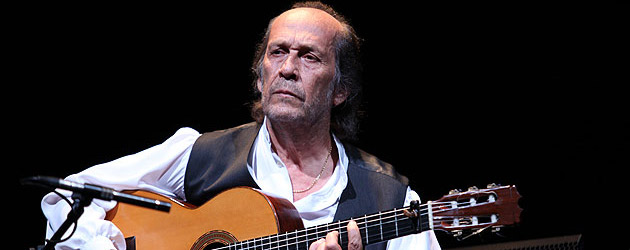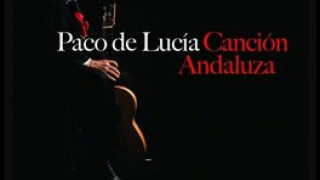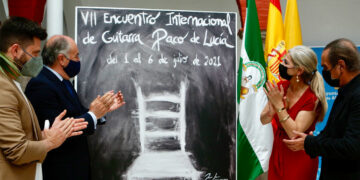Text: Estela Zatania
«The Fabulous Guitar of Paco de Lucía» … that was the title of his first solo recording… silenced forever.
The latent melancholy that always seemed present in him, is today upon all of us. The entire flamenco community, lovers of music and culture, the whole world is mourning the terrible premature loss of our Francisco Sánchez Gómez, “Paco de Lucía”.
They tell us he died while relaxing with his children on a Mexican beach near his house. Just like that, with the same natural quality he displayed in his guitar-playing, this “maestro of maestros”, a term too quickly applied to others, is gone. Nowadays no flamenco guitarist can claim not to somehow have felt the influence of the revolution that Paco de Lucía set in motion 50 years ago. In the article “Apuntes Nostálgicos”, we cited the words of Tomatito, maximum follower of Paco de Lucía: “Who doesn’t sound like Paco for God’s sake? It’s impossible. He took so many paths, made so many inroads…he’s the boss, the God of guitar”.
In addition to interpreting, he was also an instinctive composter of great sensitivity and originality. Holder of the Príncipe de Asturias de las Artes, as well as the National Prize for Guitar from the Córdoba Contest, Honoris Causa at the University of Cádiz and the Berklee College of Music in Boston, USA, Gold Medal for Merit in the Arts… All prizes and awards seem insufficient in relation to the magnitude of Paco’s genius. Today there are those who would argue whether it was Paco, or others later on, who had the greatest impact on flamenco in the last half-century. For those who lived through the era of his beginning, there is no possible discussion. Paco de Lucía changed and revolutionized flamenco in such a way that it would never be the same again; even cante and dance were touched by his innovations. And it was fully intended. The young man decided flamenco was lacking something, that it needed to grow, to broaden its harmonic and technical horizons. “Guitar is changing, and I have an obligation to my fans to open up new possibilities” declared Paco in a 1986 interview when he was already a major star in Spain and abroad, thanks primarily to the unprecedented success of his theme “Entre Dos Aguas”, which continues to be admired even after 40 years. All of Paco’s recitals included a wink to that composition, and just a few discreet notes were always enough to drive audiences wild.
He came from humble beginnings in Algeciras where his father, guitarist Antonio Sánchez, gave him the first classes and imposed the discipline that would yield such fine fruit. “De Lucía” was a reference to his mother who was so-named, and there was an older brother, the great guitarist Ramón de Algeciras. The photos with his other brother, Pepe, Los Chiquitos de Algeciras as they would record at the beginning of the sixties, both in short pants, is an image burned into the retina of flamenco’s collective memory. Legendary dancer José Greco brought him to New York when he was still an adolescent. At that time, the quiet young boy who would be seen around Mario Escudero’s studio had already awakened the interest of New York’s flamenco community, including that of the maestro Sabicas whom the boy asked to meet: a historic encounter.
Collaboration with singer Camarón de la Isla would be decisive in his career and in the history of flamenco. They complemented each other perfectly, and together designed a new way of feeling flamenco, a mix of contemporary harmony and an irresistible twang in the vocal delivery that caught the interest of a whole new audience.
Another historic encounter took place years later at the La Unión Festival de las Minas when the young guitarist accompanied the great singer Antonio Mairena with surprising maturity.
Guitarists from other genres, with scant knowledge of flamenco, would play Paco’s most famous compositions such as “La Barrosa”, without realizing it’s a form we flamencos call “alegrías”. Paco completely renovated and elaborated other classic flamenco forms, creating an entirely new repertoire of landscapes and harmonic color. He pioneered the sextet format for flamenco guitar, explored new ways of working the compás, opened a world of possibilities with alternative tunings and established a high technical level, until then unknown, which we now consider to be the norm.
Ten years ago, upon the release of his recording “Cositas Buenas”, Paco announced that he would do his last tour in January/February 2004. “The recordings are all there, the concerts just disappear with the wind”, he declared at the time. But it was not meant to be, and the maestro continued giving live recitals and touring straight through until the end. He has left us a vast discography, and various books have been written on his life and work.
The white shirt, the black vest, the crossed legs, the head tossed back in the musical ecstasy of his mind… Hey Paquito, get Camarón to sing that one about “Al verte las flores lloran”, ‘seeing you makes the flowers cry’.
More information:
Paco de Lucía en el Cante de las Minas
Descubre más desde Revista DeFlamenco.com
Suscríbete y recibe las últimas entradas en tu correo electrónico.





























